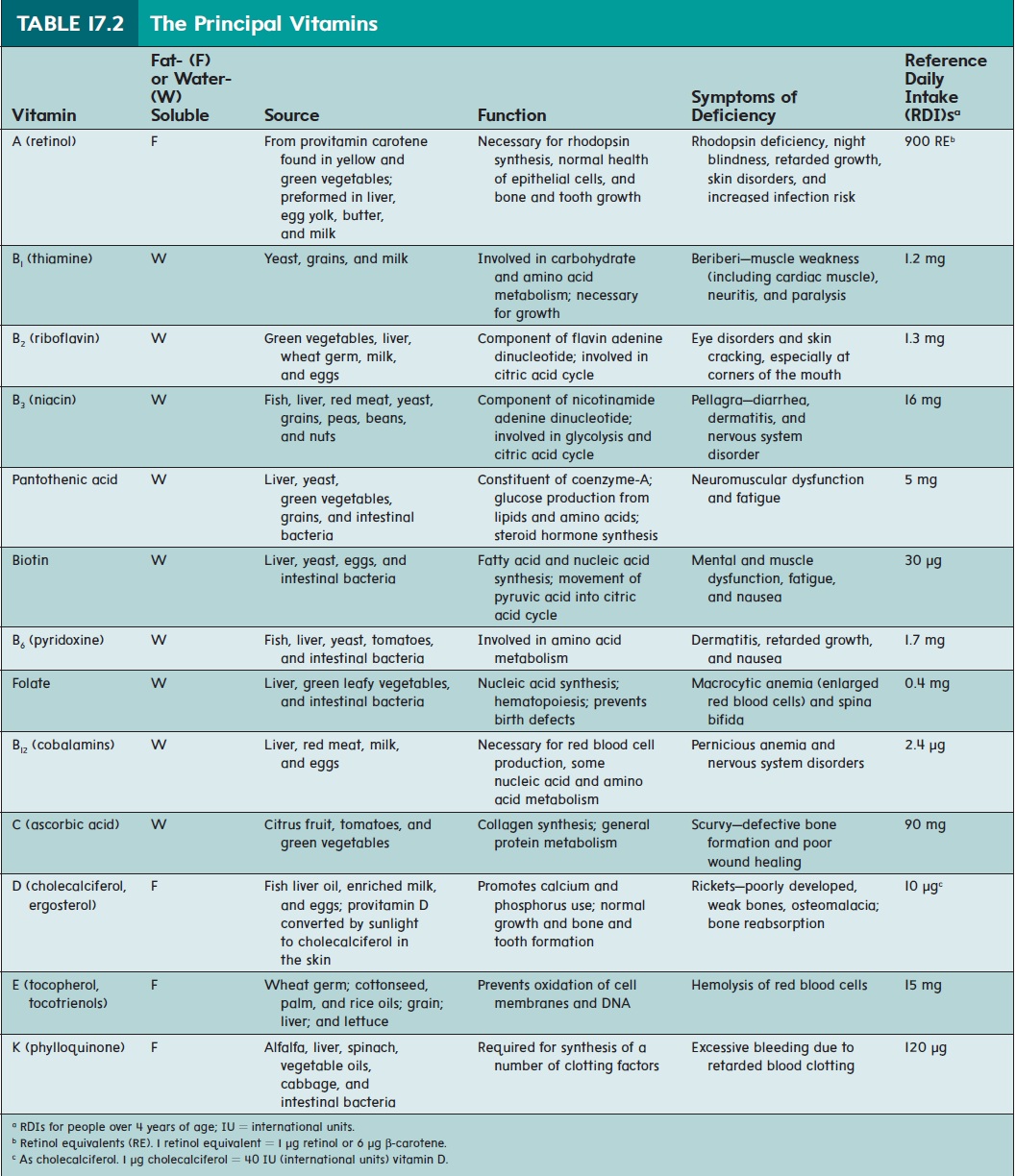Chapter: Essentials of Anatomy and Physiology: Nutrition, Metabolism, and body Temperature Regulation
Vitamins - Human Nutrition
Vitamins
Vitamins (vı̄t′ă-minz; life-giving chemicals) are organic molecules that exist in minute quantities in food and are essential to normal metabolism (table 17.2). Essential vitamins cannot be produced by the body and must be obtained through the diet. Because no single food item or nutrient class provides all the essential vitamins, it is necessary to maintain a balanced diet by eating a variety of foods. The absence of an essential vitamin in the diet can result in a specific deficiency disease. A few vita-mins, such as vitamin K, are produced by intestinal bacteria, and a few others can be formed by the body from substances called provitamins. A provitamin is a part of a vitamin that the body can assemble or modify into a functional vitamin. Beta carotene is an example of a provitamin that can be modified by the body to form vitamin A. The other provitamins are 7-dehydrocholesterol (dē -h ′ drō -kō -les′ ter-ol), which can be converted to vitamin D, and tryptophan (trip′ tō -fan), which can be converted to niacin.

Vitamins are not broken down by catabolism but are used by the body in their original or slightly modified forms. After the chemical structure of a vitamin is destroyed, its function is lost. The chemical structure of many vitamins is destroyed by heat, as when food is overcooked.
Most vitamins function as coenzymes, which combine with enzymes to make the enzymes functional . Vitamins B2 and B3, biotin (bı̄ ′ ̄o -tin), and pantothenic (pan-t̄o -then′ ik) acid are critical for some of the chemical reactions involved in the production of ATP. Folate (f̄o ′ l ̄a t) and vitamin B12 are involved in nucleic acid synthesis. Vitamins A, B1, B6, B12, C, and D are necessary for growth. Vitamin K is necessary for the synthesis of proteins involved in blood clotting (table 17.2).
Vitamins are either fat-soluble or water-soluble. Fat-solublevitamins, such as vitamins A, D, E, and K, are absorbed fromthe intestine along with lipids. Some of them can be stored in the body for a long time. Because they can be stored, these vitamins can accumulate in the body to the point of toxicity. Water-solublevitamins, such as the B vitamins and vitamin C, are absorbed withwater from the intestinal tract and typically remain in the body only a short time before being excreted in the urine.
Vitamins were first identified at the beginning of the twenti-eth century. They were found to be associated with certain foods that were known to protect people from diseases such as rickets and beriberi. In 1941, the first Food and Nutrition Board estab-lished the Recommended Dietary Allowances (RDAs), which are the nutrient intakes that are sufficient to meet the needs of nearly all people in certain age and gender groups. RDAs were established for different-aged males and females, starting with infants and continuing on to adults. RDAs were also set for pregnant and lactating women. The RDAs have been reevaluated every 4–5 years and updated, when necessary, on the basis of new information.
The RDAs establish a minimum intake of vitamins and min-erals that should protect almost everyone (97%) in a given group from diseases caused by vitamin or mineral deficiencies. Although personal requirements can vary, the RDAs are a good benchmark. The farther below the RDAs an individual’s dietary intake is, the more likely that person is to develop a nutritional deficiency. On the other hand, consuming too much of some nutrients can have harmful effects. For example, the long-term ingestion of 3–10 times the RDA for vitamin A can cause bone and muscle pain, skin disorders, hair loss, and an enlarged liver. Consuming 5–10 times the RDA of vitamin D over the long term can result in calcium deposits in the kidneys, heart, and blood vessels, and regularly consuming more than 2 g (which is more than 20 times the RDA) of vitamin C daily can cause stomach inflammation and diarrhea.
Related Topics